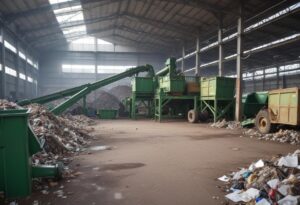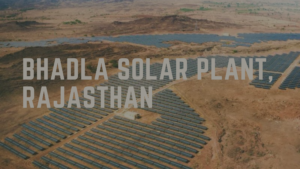
Innovative Startups: Pioneering Waste-to-Energy Solutions in India
The Progress of Rooftop Solar Installations in Urban India Introduction In recent years, India has witnessed a surge in innovative startups that are tackling one of the country’s most pressing environmental challenges—waste management. Among these, waste-to-energy startups like Carbon Masters and GPS Renewables are making significant strides. By converting waste into valuable resources like biogas and electricity, these startups are not only addressing waste disposal issues but also contributing to sustainable energy solutions. This article profiles these pioneering companies and highlights the steps taken by the Government of India to support such innovative ventures. Carbon Masters: Transforming Waste into Clean Energy Company Overview Founded in 2012, Carbon Masters is an innovative startup focused on converting organic waste into biogas and organic fertilizer. The company operates primarily in urban areas, where waste management is a critical issue. By processing organic waste from households, restaurants, and food markets, Carbon Masters produces Carbonlites—compressed biogas (CBG) and organic manure. Key Projects and Impact – Biogas Plants: Carbon Masters has established several biogas plants across India. These plants process tons of organic waste daily, producing biogas that is used for cooking and industrial applications.– Carbonlites: The company’s flagship product, Carbonlites, is a renewable energy source that can replace conventional LPG. Carbonlites are distributed in cylinders and can be used in homes, hotels, and industries.– Environmental Benefits: By converting waste into biogas and organic manure, Carbon Masters reduces methane emissions, mitigates landfill use, and provides a sustainable alternative to chemical fertilizers. GPS Renewables: Innovating Biogas Solutions Company Overview GPS Renewables, founded in 2012, is another leading startup in the waste-to-energy sector. Specializing in biogas technology, the company provides turnkey solutions for converting organic waste into biogas and organic fertilizer. GPS Renewables’ innovative approach and technology have made it a significant player in the biogas industry. Key Projects and Impact – BioUrja Plants: GPS Renewables has developed the BioUrja biogas plant, a compact and efficient system designed for urban settings. These plants are installed in various locations, including corporate campuses, hotels, and educational institutions.– Scalable Solutions: The company offers scalable solutions tailored to the specific needs of its clients, ensuring optimal waste processing and energy production.– Carbon Footprint Reduction: GPS Renewables’ biogas plants help reduce the carbon footprint by diverting organic waste from landfills and generating clean energy, which can be used for electricity generation and cooking. Government Support for Waste-to-Energy Startups The Government of India recognizes the importance of waste-to-energy technologies and has implemented various initiatives to support startups in this sector. These initiatives aim to provide financial assistance, foster innovation, and create a conducive environment for the growth of waste-to-energy projects. 1. Subsidies and Incentives: The government offers subsidies and incentives for the establishment of biogas and waste-to-energy plants. These financial aids reduce the initial investment burden and encourage more entrepreneurs to enter the sector. 2. Startup India Initiative: Launched in 2016, the Startup India initiative provides a range of benefits, including tax exemptions, easier compliance regulations, and access to funding. Waste-to-energy startups like Carbon Masters and GPS Renewables can leverage these benefits to scale their operations. 3. Pradhan Mantri Kisan Urja Suraksha evam Utthan Mahabhiyan (PM-KUSUM): This scheme promotes the installation of solar pumps and grid-connected renewable power plants. It also supports biogas projects, providing financial aid and technical assistance to startups working on biogas and waste-to-energy solutions. 4. Swachh Bharat Mission: Under the Swachh Bharat Mission, the government promotes scientific waste management practices, including waste-to-energy projects. Municipalities are encouraged to collaborate with startups to implement effective waste management solutions. 5. National Biogas and Manure Management Programme (NBMMP): This program focuses on setting up family-type biogas plants in rural areas. It provides financial support and training to beneficiaries, promoting the adoption of biogas technology. Conclusion Innovative startups like Carbon Masters and GPS Renewables are revolutionizing waste management in India by converting waste into valuable energy resources. Their efforts not only address the pressing issue of waste disposal but also contribute to the country’s renewable energy goals. With the support of government initiatives and policies, these startups are well-positioned to scale their operations and make a significant impact on India’s waste-to-energy landscape. By fostering innovation and providing financial aid, the government is playing a crucial role in promoting sustainable waste management solutions and supporting the growth of the waste-to-energy sector. Significant Municipal Solid Waste Projects in India 1. Okhla Waste to Energy Plant, Delhi The Okhla Waste to Energy (WtE) Plant is one of the largest and most advanced waste management projects in India. Operational since 2011, the plant processes around 2,000 tonnes of waste daily, converting it into electricity. The facility generates approximately 16 MW of power, enough to meet the needs of around 600,000 homes. This project has not only reduced the burden on landfills but also demonstrated the potential of waste-to-energy technology in India. 2. Ghaziabad’s Integrated Solid Waste Management Plant This plant, located in Uttar Pradesh, is designed to process 1,200 tonnes of waste per day. It includes a waste-to-energy facility, a composting unit, and a material recovery facility. The plant generates 15 MW of electricity and produces compost for agricultural use, thereby promoting sustainable waste management practices. 3. Pune’s Biogas Plants Pune has implemented several small-scale biogas plants that process organic waste from markets and households. These plants produce biogas, which is used as a clean fuel for cooking and power generation. This decentralized approach to waste management helps in reducing transportation costs and lowering greenhouse gas emissions. 4. Indore’s Cleanest City Initiative Indore, repeatedly ranked as India’s cleanest city, has implemented a robust waste segregation and processing system. The city has numerous facilities for composting, recycling, and biogas production, ensuring minimal waste is sent to landfills. Indore’s success is attributed to strong public participation, efficient municipal management, and innovative waste processing technologies. Innovative Waste Management Technologies from Around the World 1. Anaerobic Digestion (AD) Anaerobic digestion is a biological process that breaks down organic waste in the absence of oxygen, producing biogas and digestate. Countries like Germany and















